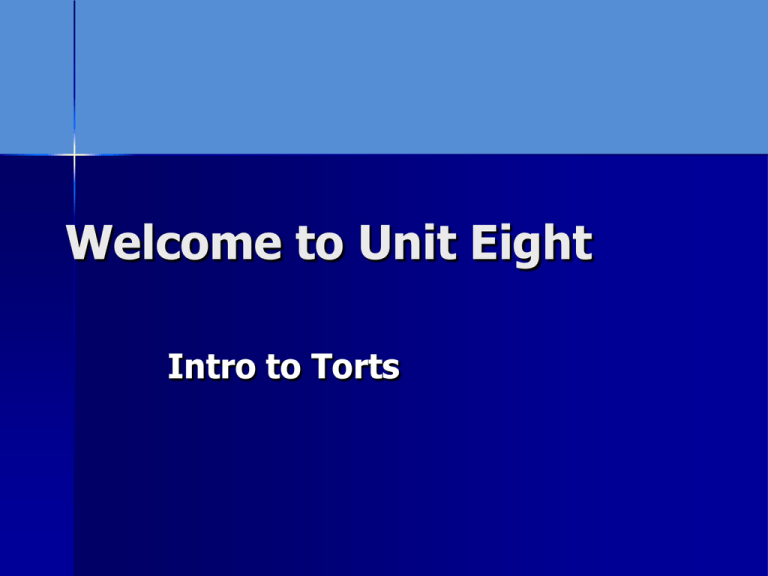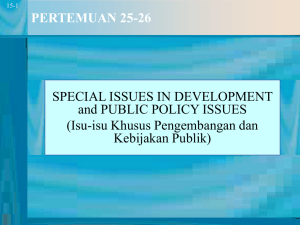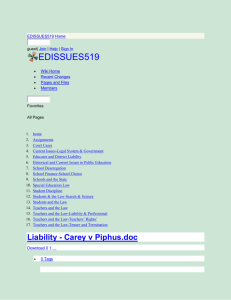Document
advertisement

Welcome to Unit Eight Intro to Torts What Are We Studying This Unit? Strict (also called Absolute) Liability – Abnormally Dangerous Activities – Mass Torts – Animal Owners’ Liability – Proximate Cause Products Liability – Theory and History – Elements – Bad Faith Strict (Absolute) Liability Strict liability holds a tortfeasor responsible for misconduct regardless of whether the tortfeasor was at fault. Strict liability is restricted to certain types of very dangerous activities, including ultrahazardous materials, defective product and such as wild/vicious animals. Strict Liability Limitations: Because one is at fault regardless of care taken, this is a very limited area. Reasoning: the risk of liability is better placed on those who engage in ultrahazardous activities Ultrahazardous (Abnormally Dangerous) Activities An abnormally dangerous activity creates high risk of substantial injury to victim or victim’s property. The risk cannot be removed through use of reasonable care (why it’s different from negligence) The activity or substance is not commonly undertaken or used (“common usage” principle). Ultrahazardous (Abnormally Dangerous) Activities (Sometimes) The activity was inappropriately undertaken in place in which victim was harmed. Hazards that were created outweigh the benefits that the activity brings to community (another balancing test). Defenses Statutory protection Common law defenses protecting public utilities, private contractors or municipal zoos. If there is statutory protection, then the analysis goes back to negligence. Proximate Cause (slide 1 of 2) Remember for both Abnormally Dangerous Activities and Animal cases: The plaintiff ’s injuries must have been a reasonably foreseeable consequence of the defendant’s actions. The victim must have been a foreseeable plaintiff (meaning that it must have been reasonably foreseeable that the plaintiff would be injured as a result of the defendant’s activities). These elements are defined the same as in negligence theory. Proximate Cause The victim must have been a foreseeable plaintiff (meaning that it must have been reasonably foreseeable that the plaintiff would be injured as a result of the defendant’s activities). These elements are defined the same as in negligence theory. Mass Tort When a large group of people are injured as a result of a single tortious act, this is called a mass tort. This is distinguished from a class action where a small group of plaintiffs are harmed. Where the Wild Things Are: Wild Animals Liability (slide 1 of 2) Wild Animals – Defined: Ferae naturae = “wild nature.” Lions, Tigers and Bears, oh my! (Also snakes, and bees and chimps—any animal that can’t be fully tamed) Wild Animal Ownership: The person exercising dominion and control over the wild animal is the legal owner of the beast. Where the Wild Things Are: Wild Animals Liability If the wildlife escapes control, then former possessor loses ownership until animal is recaptured by him or her—no liability of no ownership. Absolute Liability: Owners are strictly liable for injuries caused by their wild animals—even if the owner took care with the animals. Domestic Bliss—Domestic Animals (slide 1 of 2) Domestic Animal Defined: Domitae naturae = “domesticated nature.” Tame animals (domestic livestock, dogs, cats, etc). Ordinary Liability Rule: Owners are liable for injuries caused by their domestic animals only based upon other torts, such as negligence, or certain intentional torts, such as assault, battery, and false imprisonment. Domestic Animals Vicious Propensity Rule: Owners are absolutely liable for injuries caused by their domestic animals only when those animals have vicious propensities. Vicious propensity= The domestic animal’s behavior (reputation) in past biting or attack episodes, in which the animal has hurt people (or property). State Dog-Bite Statutes: Most states have statutes that determine owner liability (and available defenses) in dog-bite Cases. Defenses Strict Liability, but…there are exceptions for animal cases – Assumption of Risk – Contributory or Comparative Negligence – Consent – Self-Defense or Defense of Others – Provocation Products Liability Historical: Privity of Contract Winterbottom v. Wright (no privity, no case) Exception: Imminent Danger Thomas v. Winchester (privity not required for dangerous products) Products Liability MacPherson v. Buick Motor Co. Privity not required for defective products California Case:Escola v. Coca Cola Bottling Co. suggests strict liability for products cases Public Policy: Business best bears the costs Products Liability Parties Manufacturers: Makers of defective products giving rise to lawsuit. Sellers: – Anyone in business of selling goods such as defective one. – Includes manufacturers, wholesalers, and retailers. Ultimate User: the reasonably foreseeable user of defective product – Purchasers that use defective product. – Persons who use defective product that purchaser bought (usually family members, friends, employees) Products Liability Elements (slide 1 of 2) Typical analysis: A defect renders product unreasonably dangerous to use (flawed design, flawed manufacture, or failure to warn). The seller or manufacturer must be in business of selling products such as flawed one. The product cannot have been substantially changed between time it left seller or manufacturer’s hands and time it reached ultimate user. Ultimate user must have used product Products Liability Elements Additional Elements (used in some jurisdictions): The ultimate user must have been foreseeable. The seller or manufacturer must have been responsible for condition in which product was maintained. In a few states, a product sale must have occurred. Products Liability Proximate Cause: Defective product must proximately cause ultimate user’s injuries. Liability rule applies although: – Seller has exercised all possible care in preparing and selling defective product. – User or consumer has not bought product from, or formed contract with, seller. Unreasonably Dangerous Defective Products (slide 1 of 2) Fault in Product Design: – Product unreasonably dangerous because of faulty design. (2) Court tests for faulty design: (a) Consumer Contemplation Test—Product is unreasonably dangerous if consumer ordinarily would not reasonably anticipate danger created through its design. (b) Danger/Utility Test—Product is unreasonably dangerous if danger created by its design outweighs benefits derived from its use. (c) State-of-the-Art Discoverability test—If manufacturer could have discovered hazards created by defective product designs, using current, state-of-the-art technologies, then failure to do so makes design-flawed product unreasonably dangerous. Unreasonably Dangerous Defective Products: Error in product manufacture or assembly: Defects were created while product was being manufactured or assembled. Improper Product Maintenance: (1) Seller failed to properly maintain product before injured user used it. (2) This failure makes product unreasonably dangerous. Manufacturer or seller’s failure to warn user of product dangers: Product becomes unreasonably dangerous because of manufacturer’s or seller’s failure to warn user of potential dangers. Defenses to Products Liability Ultimate User’s Misuse of Product= uses that were not reasonably foreseeable. (Some misuses can be foreseeable). Assumption of Risk Contributory negligence is not a defense however, some statutes specifically allow comparative negligence. Bad Faith A tort that has developed from situations where an insurance company unreasonably denies a claim or fails to pay a claim in a timely fashion within the policy limits. A Little Reminder…. You all are doing a great job!!! Questions?





